Nebular hypothesis
| Star formation |
|---|
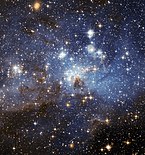 |
| Object classes |
| Theoretical concepts |
The nebular hypothesis is the most widely accepted model in the field of
According to the nebular theory, stars form in massive and dense clouds of
The protoplanetary disk is an accretion disk that feeds the central star.[3] Initially very hot, the disk later cools in what is known as the T Tauri star stage; here, formation of small dust grains made of rocks and ice is possible. The grains eventually may coagulate into kilometer-sized planetesimals. If the disk is massive enough, the runaway accretions begin, resulting in the rapid—100,000 to 300,000 years—formation of Moon- to Mars-sized planetary embryos. Near the star, the planetary embryos go through a stage of violent mergers, producing a few terrestrial planets. The last stage takes approximately 100 million to a billion years.[2]
The formation of giant planets is a more complicated process. It is thought to occur beyond the frost line, where planetary embryos mainly are made of various types of ice. As a result, they are several times more massive than in the inner part of the protoplanetary disk. What follows after the embryo formation is not completely clear. Some embryos appear to continue to grow and eventually reach 5–10 Earth masses—the threshold value, which is necessary to begin accretion of the hydrogen–helium gas from the disk.[4] The accumulation of gas by the core is initially a slow process, which continues for several million years, but after the forming protoplanet reaches about 30 Earth masses (ME) it accelerates and proceeds in a runaway manner. Jupiter- and Saturn-like planets are thought to accumulate the bulk of their mass during only 10,000 years. The accretion stops when the gas is exhausted. The formed planets can migrate over long distances during or after their formation. Ice giants such as Uranus and Neptune are thought to be failed cores, which formed too late when the disk had almost disappeared.[2]
History
There is evidence that
Pierre-Simon Laplace independently developed and proposed a similar model in 1796[1] in his Exposition du systeme du monde. He envisioned that the Sun originally had an extended hot atmosphere throughout the volume of the Solar System. His theory featured a contracting and cooling protosolar cloud—the protosolar nebula. As this cooled and contracted, it flattened and spun more rapidly, throwing off (or shedding) a series of gaseous rings of material; and according to him, the planets condensed from this material. His model was similar to Kant's, except more detailed and on a smaller scale.[1] While the Laplacian nebular model dominated in the 19th century, it encountered a number of difficulties. The main problem involved angular momentum distribution between the Sun and planets. The planets have 99% of the angular momentum, and this fact could not be explained by the nebular model.[1] As a result, astronomers largely abandoned this theory of planet formation at the beginning of the 20th century.
According to some, a major critique came during the 19th century from
The perceived deficiencies of the Laplacian model stimulated scientists to find a replacement for it. During the 20th century many theories addressed the issue, including the planetesimal theory of Thomas Chamberlin and Forest Moulton (1901), the tidal model of James Jeans (1917), the accretion model of Otto Schmidt (1944), the protoplanet theory of William McCrea (1960) and finally the capture theory of Michael Woolfson.[1] In 1978 Andrew Prentice resurrected the initial Laplacian ideas about planet formation and developed the modern Laplacian theory.[1] None of these attempts proved completely successful, and many of the proposed theories were descriptive.
The birth of the modern widely accepted theory of planetary formation—the solar nebular disk model (SNDM)—can be traced to the Soviet astronomer
Solar nebular model: achievements and problems
Achievements
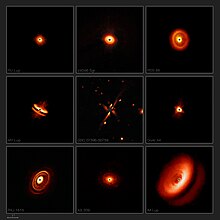
The star formation process naturally results in the appearance of accretion disks around young stellar objects.[16] At the age of about 1 million years, 100% of stars may have such disks.[17] This conclusion is supported by the discovery of the gaseous and dusty disks around protostars and T Tauri stars as well as by theoretical considerations.[18] Observations of these disks show that the dust grains inside them grow in size on short (thousand-year) time scales, producing 1 centimeter sized particles.[19]
The accretion process, by which 1 km
Current issues
The physics of accretion disks encounters some problems.[22] The most important one is how the material, which is accreted by the protostar, loses its angular momentum. One possible explanation suggested by Hannes Alfvén was that angular momentum was shed by the solar wind during its T Tauri star phase. The momentum is transported to the outer parts of the disk by viscous stresses.[23] Viscosity is generated by macroscopic turbulence, but the precise mechanism that produces this turbulence is not well understood. Another possible process for shedding angular momentum is magnetic braking, where the spin of the star is transferred into the surrounding disk via that star's magnetic field.[24] The main processes responsible for the disappearance of the gas in disks are viscous diffusion and photo-evaporation.[25][26]
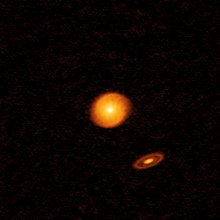
The formation of planetesimals is the biggest unsolved problem in the nebular disk model. How 1 cm sized particles coalesce into 1 km planetesimals is a mystery. This mechanism appears to be the key to the question as to why some stars have planets, while others have nothing around them, not even dust belts.[28]
The formation timescale of giant planets is also an important problem. Old theories were unable to explain how their cores could form fast enough to accumulate significant amounts of gas from the quickly disappearing protoplanetary disk.[20][29] The mean lifetime of the disks, which is less than ten million (107) years, appeared to be shorter than the time necessary for the core formation.[17] Much progress has been done to solve this problem and current models of giant planet formation are now capable of forming Jupiter (or more massive planets) in about 4 million years or less, well within the average lifetime of gaseous disks.[30][31][32]
Another potential problem of giant planet formation is their orbital migration. Some calculations show that interaction with the disk can cause rapid inward migration, which, if not stopped, results in the planet reaching the "central regions still as a sub-Jovian object."[33] More recent calculations indicate that disk evolution during migration can mitigate this problem.[34]
Formation of stars and protoplanetary disks
Protostars
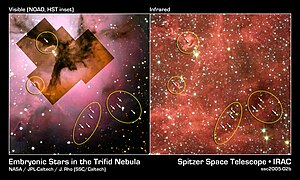
The initial collapse of a solar-mass protostellar nebula takes around 100,000 years.
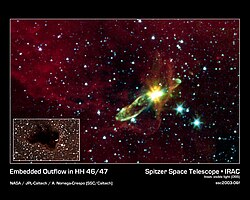
As the infall of its material onto the disk continues, the envelope eventually becomes thin and transparent and the
At the next stage the envelope completely disappears, having been gathered up by the disk, and the protostar becomes a classical T Tauri star.
Protoplanetary disks
Under certain circumstances the disk, which can now be called protoplanetary, may give birth to a

The main problem in the physics of accretion disks is the generation of turbulence and the mechanism responsible for the high
The lifespan of the accretion disks is about 10 million years.
Dust particles tend to stick to each other in the dense disk environment, leading to the formation of larger particles up to several centimeters in size.[54] The signatures of the dust processing and coagulation are observed in the infrared spectra of the young disks.[19] Further aggregation can lead to the formation of planetesimals measuring 1 km across or larger, which are the building blocks of planets.[2][54] Planetesimal formation is another unsolved problem of disk physics, as simple sticking becomes ineffective as dust particles grow larger.[28]
One hypothesis is formation by gravitational instability. Particles several centimeters in size or larger slowly settle near the middle plane of the disk, forming a very thin—less than 100 km—and dense layer. This layer is gravitationally unstable and may fragment into numerous clumps, which in turn collapse into planetesimals.[2][28] However, the differing velocities of the gas disk and the solids near the mid-plane can generate turbulence which prevents the layer from becoming thin enough to fragment due to gravitational instability.[55] This may limit the formation of planetesimals via gravitational instabilities to specific locations in the disk where the concentration of solids is enhanced.[56]
Another possible mechanism for the formation of planetesimals is the streaming instability in which the drag felt by particles orbiting through gas creates a feedback effect causing the growth of local concentrations. These local concentrations push back on the gas creating a region where the headwind felt by the particles is smaller. The concentration is thus able to orbit faster and undergoes less radial drift. Isolated particles join these concentrations as they are overtaken or as they drift inward causing it to grow in mass. Eventually these concentrations form massive filaments which fragment and undergo gravitational collapse forming planetesimals the size of the larger asteroids.[57]
Planetary formation can also be triggered by gravitational instability within the disk itself, which leads to its fragmentation into clumps. Some of them, if they are dense enough, will collapse,[52] which can lead to rapid formation of gas giant planets and even brown dwarfs on the timescale of 1,000 years.[58] If these clumps migrate inward as the collapse proceeds tidal forces from the star can result in a significant mass loss leaving behind a smaller body.[59] However it is only possible in massive disks—more massive than 0.3 M☉. In comparison, typical disk masses are 0.01–0.03 M☉. Because the massive disks are rare, this mechanism of planet formation is thought to be infrequent.[2][22] On the other hand, it may play a major role in the formation of brown dwarfs.[60]
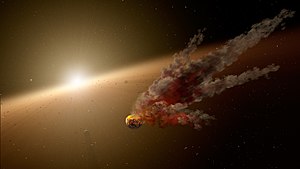
The ultimate dissipation of protoplanetary disks is triggered by a number of different mechanisms. The inner part of the disk is either accreted by the star or ejected by the bipolar jets,[45][46] whereas the outer part can evaporate under the star's powerful UV radiation during the T Tauri stage[61] or by nearby stars.[48] The gas in the central part can either be accreted or ejected by the growing planets, while the small dust particles are ejected by the radiation pressure of the central star. What is finally left is either a planetary system, a remnant disk of dust without planets, or nothing, if planetesimals failed to form.[2]
Because planetesimals are so numerous, and spread throughout the protoplanetary disk, some survive the formation of a planetary system. Asteroids are understood to be left-over planetesimals, gradually grinding each other down into smaller and smaller bits, while comets are typically planetesimals from the farther reaches of a planetary system. Meteorites are samples of planetesimals that reach a planetary surface, and provide a great deal of information about the formation of the Solar System. Primitive-type meteorites are chunks of shattered low-mass planetesimals, where no thermal differentiation took place, while processed-type meteorites are chunks from shattered massive planetesimals.[62] Interstellar objects could have been captured, and become part of the young Solar system.[63]
Formation of planets
Rocky planets
According to the solar nebular disk model,
After small planetesimals—about 1 km in diameter—have formed by one way or another, runaway accretion begins.[20] It is called runaway because the mass growth rate is proportional to R4~M4/3, where R and M are the radius and mass of the growing body, respectively.[65] The specific (divided by mass) growth accelerates as the mass increases. This leads to the preferential growth of larger bodies at the expense of smaller ones.[20] The runaway accretion lasts between 10,000 and 100,000 years and ends when the largest bodies exceed approximately 1,000 km in diameter.[20] Slowing of the accretion is caused by gravitational perturbations by large bodies on the remaining planetesimals.[20][65] In addition, the influence of larger bodies stops further growth of smaller bodies.[20]
The next stage is called oligarchic accretion.
The last stage of rocky planet formation is the merger stage.[2] It begins when only a small number of planetesimals remains and embryos become massive enough to perturb each other, which causes their orbits to become chaotic.[21] During this stage embryos expel remaining planetesimals, and collide with each other. The result of this process, which lasts for 10 to 100 million years, is the formation of a limited number of Earth-sized bodies. Simulations show that the number of surviving planets is on average from 2 to 5.[2][21][62][66] In the Solar System they may be represented by Earth and Venus.[21] Formation of both planets required merging of approximately 10–20 embryos, while an equal number of them were thrown out of the Solar System.[62] Some of the embryos, which originated in the asteroid belt, are thought to have brought water to Earth.[64] Mars and Mercury may be regarded as remaining embryos that survived that rivalry.[62] Rocky planets which have managed to coalesce settle eventually into more or less stable orbits, explaining why planetary systems are generally packed to the limit; or, in other words, why they always appear to be at the brink of instability.[21]
Giant planets
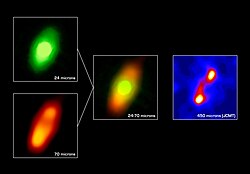
The formation of
Giant planet core formation is thought to proceed roughly along the lines of the terrestrial planet formation.[20] It starts with planetesimals that undergo runaway growth, followed by the slower oligarchic stage.[65] Hypotheses do not predict a merger stage, due to the low probability of collisions between planetary embryos in the outer part of planetary systems.[65] An additional difference is the composition of the planetesimals, which in the case of giant planets form beyond the so-called frost line and consist mainly of ice—the ice to rock ratio is about 4 to 1.[29] This enhances the mass of planetesimals fourfold. However, the minimum mass nebula capable of terrestrial planet formation can only form 1–2 ME cores at the distance of Jupiter (5 AU) within 10 million years.[65] The latter number represents the average lifetime of gaseous disks around Sun-like stars.[17] The proposed solutions include enhanced mass of the disk—a tenfold increase would suffice;[65] protoplanet migration, which allows the embryo to accrete more planetesimals;[29] and finally accretion enhancement due to gas drag in the gaseous envelopes of the embryos.[29][32][69] Some combination of the above-mentioned ideas may explain the formation of the cores of gas giant planets such as Jupiter and perhaps even Saturn.[22] The formation of planets like Uranus and Neptune is more problematic, since no theory has been capable of providing for the in situ formation of their cores at the distance of 20–30 AU from the central star.[2] One hypothesis is that they initially accreted in the Jupiter-Saturn region, then were scattered and migrated to their present location.[70] Another possible solution is the growth of the cores of the giant planets via pebble accretion. In pebble accretion objects between a cm and a meter in diameter falling toward a massive body are slowed enough by gas drag for them to spiral toward it and be accreted. Growth via pebble accretion may be as much as 1000 times faster than by the accretion of planetesimals.[71]
Once the cores are of sufficient mass (5–10 ME), they begin to gather gas from the surrounding disk.
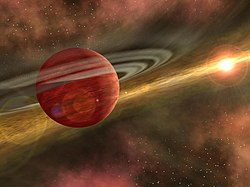
Giant planets can significantly influence terrestrial planet formation. The presence of giants tends to increase eccentricities and inclinations (see Kozai mechanism) of planetesimals and embryos in the terrestrial planet region (inside 4 AU in the Solar System).[62][66] If giant planets form too early, they can slow or prevent inner planet accretion. If they form near the end of the oligarchic stage, as is thought to have happened in the Solar System, they will influence the merges of planetary embryos, making them more violent.[62] As a result, the number of terrestrial planets will decrease and they will be more massive.[73] In addition, the size of the system will shrink, because terrestrial planets will form closer to the central star. The influence of giant planets in the Solar System, particularly that of Jupiter, is thought to have been limited because they are relatively remote from the terrestrial planets.[73]
The region of a planetary system adjacent to the giant planets will be influenced in a different way.[66] In such a region, eccentricities of embryos may become so large that the embryos pass close to a giant planet, which may cause them to be ejected from the system.[d][62][66] If all embryos are removed, then no planets will form in this region.[66] An additional consequence is that a huge number of small planetesimals will remain, because giant planets are incapable of clearing them all out without the help of embryos. The total mass of remaining planetesimals will be small, because cumulative action of the embryos before their ejection and giant planets is still strong enough to remove 99% of the small bodies.[62] Such a region will eventually evolve into an asteroid belt, which is a full analog of the asteroid belt in the Solar System, located from 2 to 4 AU from the Sun.[62][66]
Exoplanets
Thousands of exoplanets have been identified in the last twenty years, with, at the very least, billions more, within our observable universe, yet to be discovered.[74] The orbits of many of these planets and systems of planets differ significantly from the planets in the Solar System. The exoplanets discovered include hot-Jupiters, warm-Jupiters, super-Earths, and systems of tightly packed inner planets.
The hot-Jupiters and warm-Jupiters are thought to have migrated to their current orbits during or following their formation. A number of possible mechanisms for this migration have been proposed. Type I or Type II migration could smoothly decrease the semimajor axis of the planet's orbit resulting in a warm- or hot-Jupiter. Gravitational scattering by other planets onto eccentric orbits with a perihelion near the star followed by the circularization of its orbit due to tidal interactions with the star can leave a planet on a close orbit. If a massive companion planet or star on an inclined orbit was present an exchange of inclination for eccentricity via the Kozai mechanism raising eccentricities and lowering perihelion followed by circularization can also result in a close orbit. Many of the Jupiter-sized planets have eccentric orbits which may indicate that gravitational encounters occurred between the planets, although migration while in resonance can also excite eccentricities.[75] The in situ growth of hot Jupiters from closely orbiting super Earths has also been proposed. The cores in this hypothesis could have formed locally or at a greater distance and migrated close to the star.[76]
Super-Earths and other closely orbiting planets are thought to have either formed in situ or ex situ, that is, to have migrated inward from their initial locations.[77] The in situ formation of closely orbiting super-Earths would require a massive disk, the migration of planetary embryos followed by collisions and mergers, or the radial drift of small solids from farther out in the disk. The migration of the super-Earths, or the embryos that collided to form them, is likely to have been Type I due to their smaller mass. The resonant orbits of some of the exoplanet systems indicates that some migration occurred in these systems, while the spacing of the orbits in many of the other systems not in resonance indicates that an instability likely occurred in those systems after the dissipation of the gas disk. The absence of Super-Earths and closely orbiting planets in the Solar System may be due to the previous formation of Jupiter blocking their inward migration.[78]
The amount of gas a super-Earth that formed in situ acquires may depend on when the planetary embryos merged due to giant impacts relative to the dissipation of the gas disk. If the mergers happen after the gas disk dissipates terrestrial planets can form, if in a transition disk a super-Earth with a gas envelope containing a few percent of its mass may form. If the mergers happen too early runaway gas accretion may occur leading to the formation of a gas giant. The mergers begin when the dynamical friction due to the gas disk becomes insufficient to prevent collisions, a process that will begin earlier in a higher metallicity disk.[79] Alternatively gas accretion may be limited due to the envelopes not being in hydrostatic equilibrium, instead gas may flow through the envelope slowing its growth and delaying the onset of runaway gas accretion until the mass of the core reaches 15 Earth masses.[80]
Meaning of accretion
Use of the term "
However, that meaning should not be confused with the process of accretion forming the planets. In this context, accretion refers to the process of cooled, solidified grains of dust and ice orbiting the protostar in the protoplanetary disk, colliding and sticking together and gradually growing, up to and including the high-energy collisions between sizable planetesimals.[20]
In addition, the giant planets probably had accretion disks of their own, in the first meaning of the word.[81] The clouds of captured hydrogen and helium gas contracted, spun up, flattened, and deposited gas onto the surface of each giant protoplanet, while solid bodies within that disk accreted into the giant planet's regular moons.[82]
See also
- Asteroid belt
- Bok globule
- Comet
- Exocomet
- Formation and evolution of the Solar System
- Herbig–Haro object
- History of Earth
- Kuiper belt
- Oort cloud
- T Tauri star
Notes
- ^ Compare it with the particle number density of the air at the sea level—2.8×1019 cm−3.
- ^ The T Tauri stars are young stars with mass less than about 2.5 M☉ showing a heightened level of activity. They are divided into two classes: weakly lined and classical T Tauri stars.[43] The latter have accretion disks and continue to accrete hot gas, which manifests itself by strong emission lines in their spectrum. The former do not possess accretion disks. Classical T Tauri stars evolve into weakly lined T Tauri stars.[44]
- ^ The planetesimals near the outer edge of the terrestrial planet region—2.5 to 4 AU from the Sun—may accumulate some amount of ice. However the rocks will still dominate, like in the outer main belt in the Solar System.[64]
- ^ As a variant they may collide with the central star or a giant planet.
References
- ^ Bibcode:1993QJRAS..34....1W. For details of Kant's position, see Stephen Palmquist, "Kant's Cosmogony Re-Evaluated", Studies in History and Philosophy of Science 18:3 (September 1987), pp.255–269.
- ^ S2CID 120504344.
- ^ Andrews, Robin George (10 August 2022). "Astronomers May Have Found the Galaxy's Youngest Planet - The Webb telescope soon will help measure the world, which may offer insights into how our own formed". The New York Times. Retrieved 11 August 2022.
- S2CID 118522228.
- ^ Swedenborg, Emanuel (1734). (Principia) Latin: Opera Philosophica et Mineralia (English: Philosophical and Mineralogical Works). Vol. I.
- ^ Baker, Gregory L. "Emanuel Swenborg – an 18th century cosomologist". The Physics Teacher. October 1983, pp. 441–446.
- ^ George H. A. Cole (2013). Planetary Science: The Science of Planets around Stars, Second Edition, Michael M. Woolfson, p. 190
- ^ Petzold, Charles (February 2005). "Maxwell, Molecules, and Evolution". Retrieved 2023-01-03.
- ^ Brester, David (1876), "More Worlds Than One: The Creed of the Philosopher and the Hope of the Christian", Chatto and Windus, Piccadilly, p. 153
- ^ As quoted by David Brewster, "More worlds than one : the creed of the philosopher and the hope of the Christian", Fixed stars and binary systems. p. 233
- ^ Henbest, Nigel (1991). "Birth of the planets: The Earth and its fellow planets may be survivors from a time when planets ricocheted around the Sun like ball bearings on a pinball table". New Scientist. Retrieved 2008-04-18.
- ISBN 978-0-7065-1225-0.
- .
- ^ Schneider, Jean (10 September 2011). "Interactive Extra-solar Planets Catalog". Extrasolar Planets Encyclopaedia. Retrieved 2011-09-10.
- ^ "SPHERE Reveals Fascinating Zoo of Discs Around Young Stars". www.eso.org. Retrieved 11 April 2018.
- ^ doi:10.1086/173608.
- ^ S2CID 16480998.
- ^ S2CID 16498360.
- ^ S2CID 118938125.
- ^ doi:10.1086/344105.
- ^ S2CID 119069411.
- ^ ISBN 9781402023040.
- ^ .
- ^ Devitt, Terry (January 31, 2001). "What Puts The Brakes On Madly Spinning Stars?". University of Wisconsin-Madison. Retrieved 2013-04-09.
- ISBN 978-0816526543.
- ISBN 9780226282282.
- ^ "Worlds with many suns". www.eso.org. Retrieved 11 February 2019.
- ^ S2CID 299829.
- ^ doi:10.1016/j.icarus.2003.08.001. Archived from the original(PDF) on 2006-09-12.
- S2CID 18964068.
- ^ S2CID 118553341.
- ^ S2CID 118572605.
- ^ Papaloizou 2007 page 10
- ^ Bibcode:2010exop.book..319D.
- ^ S2CID 33585808.
- .
- ^ Bibcode:1998A&A...336..150M.
- ^ doi:10.1086/158459.
- ^ doi:10.1086/173678.
- ^ doi:10.1086/307867.
- S2CID 118351543.
- ^ doi:10.1086/166694.
- S2CID 8462683.
- Bibcode:1994A&A...282..503M.
- ^ doi:10.1086/305277.
- ^ .
- ^ doi:10.1086/319779.
- ^ S2CID 16093937.
- ^ Harrington, J.D.; Villard, Ray (24 April 2014). "RELEASE 14–114 Astronomical Forensics Uncover Planetary Disks in NASA's Hubble Archive". NASA. Archived from the original on 2014-04-25. Retrieved 2014-04-25.
- S2CID 119007015.
- ^ doi:10.1086/303700.
- ^ S2CID 119362731.
- ^ "ALMA Sheds Light on Planet-Forming Gas Streams". ESO Press Release. Retrieved 10 January 2013.
- ^ S2CID 15477674.
- S2CID 15999094.
- S2CID 119300087.
- S2CID 118709894.
- ^ doi:10.1086/379163.
- S2CID 53409577.
- S2CID 17139868.
- S2CID 15928892.
- ^ .
- S2CID 119066860.
- ^ S2CID 10257401.
- ^ S2CID 16522991.
- ^ doi:10.1006/icar.2001.6702. Archived from the original(PDF) on 2007-02-21. Retrieved 2008-03-18.
- ^ S2CID 116913980.
- ^ S2CID 119217803.
- ^ S2CID 14812137.
- S2CID 4368864.
- S2CID 53961588.
- ^ Bibcode:2007prpl.conf..655P.
- ^ S2CID 41888579.
- ^ "Are We Alone? Discovery of Billions of Earth-Like Planets May Hold the Answer". SciTechDaily. July 8, 2020.
- S2CID 67790867.
- S2CID 25105765.
- S2CID 119203398.
- S2CID 119122001.
- S2CID 118456061.
- S2CID 118979289.
- S2CID 119216797.
- S2CID 47631608.
External links
- The American Cyclopædia.


